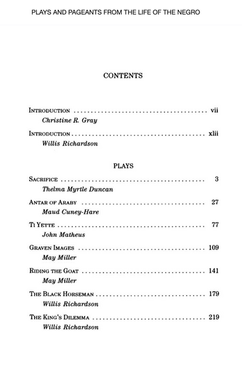May Miller
Educator, Facilitor, Playwright
1899-1995
Years:
Affiliations:
Howard University, Frederick Douglas High School
Baltimore, Washington DC
Locations:
Connections:
WEB Du Bois, Mary Burrill, Angelina Weld Grimke, Willis Richardson

Born in Washington, D.C., the daughter of a Howard University sociologist, Miller grew up in an intellectual household where W.E.B. Du Bois and Booker T. Washington were frequent guests. Miller attended Dunbar High School in DC, where she studied under famous playwrights Mary P. Burrill and Angelina Weld Grimké. She attended Howard University as a drama major were she directed, acted, and produced plays while collaborating with Alain Locke and Montgomery Gregory in the founding of a Black drama movement. Miller was the most widely published female playwright of the Harlem Renaissance. Miller spent twenty years teaching Speech, English, Theater, and Dance at Frederick Douglass High School in Baltimore, Maryland. While in Baltimore, she worked with the Krigwa Players (a multi-city theatre company, co-founded by W.E.B. Du Bois and Regina M. Anderson).
When the D.C. Commission on the Arts and Humanities was established, Miller was named chair of the Literature Panel for three terms.
As a playwright, she openly addressed racial issues in plays such as Scratches (1929), which commented on color and class bias within the Black community; Stragglers in the Dust (1930), about African Americans in the military; and Nails and Thorns (1933), which dramatized lynching. In 1930, two of Miller’s plays, “Graven Images” and “Ridin’ the Goat,” were anthologized in Plays and Pageants from the Life of the Negro. You can find additional information on May Miller in the introduction of the original and most recent versions of this text. She also wrote many historical plays, four of which (including Harriet Tubman and Sojourner Truth) were anthologized in Negro History in Thirteen Plays (1935), for which she was a co-editor with Willis Richardson.
May Miller developed her writing in a society in which literature created by whites “influenc[ed] the readers’ perception of blacks through the use of degrading and destructive stereotypes.” Later, as a member of Georgia Douglas Johnson’s S Street Salon, Miller and her contemporaries in the Harlem Renaissance pushed against such depictions to represent African American life and perspectives in their work.[1] Over the course of her life, Miller would compose over twenty plays that brought historical events into a current context, including slavery, lynching, and class bias.
The Rose Library holds three copies of Miller’s play about Harriet Tubman: two typescripts entitled “Harriet Tubman, Black Moses (A One-Act Play)” and one handwritten copy entitled “Go Down Moses (A One-Act Play).” Miller or her editor appears to have debated the play’s title; on both of the typescripts, “Go Down Moses” is scratched out, and “Harriet Tubman, Black Moses” is written above it. Miller portrayed the past as very much connected to the present, particularly through women’s roles. As Ethyl A. Young-Minor has argued, the play “radically displays black women as central and active agents on the stage.” Young-Minor, 33-34.
For an interview with May Miller, visit: https://www.beltwaypoetry.com/interview-with-may-miller/
For a podcast episode about May Miller, visit: https://broadwaypodcastnetwork.com/podcasts/icons-harlem-renaissance-in-motion/may-miller/3
For more: https://minttheater.org/lost-voices-in-black-history/?tab=maymiller





